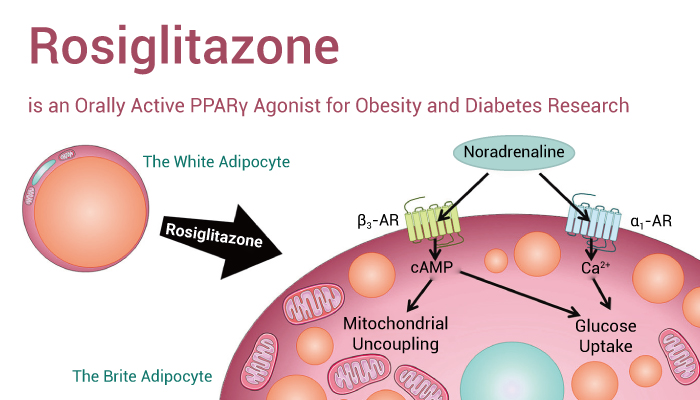PPARs (Peroxisome proliferator-activated receptors) are ligand-activated transcription factors of nuclear hormone receptor superfamily comprising of the following three subtypes: PPARα, PPARγ, and PPARβ/δ. Among them, PPARγ regulates fatty acid storage and glucose metabolism. There are two isoforms of PPARγ in humans and mice: PPAR-γ1 (found in nearly all tissues except muscle) and PPAR-γ2 (mostly found in adipose tissue and the intestine). The genes activated by PPARγ stimulate lipid uptake and adipogenesis by fat cells. Furthermore, PPARγ increases insulin sensitivity by enhancing storage of fatty acids in fat cells (reducing lipotoxicity), by enhancing adiponectin release from fat cells, by inducing FGF21, and by enhancing nicotinic acid adenine dinucleotide phosphate production through upregulation of the CD38 enzyme. Besides, PPARγ promotes anti-inflammatory M2 macrophage activation in mice.
Rosiglitazone (also known as BRL 49653), a thiazolidinedione derivative, is an orally active, selective PPARγ agonist with an EC50 of 60 nM and a Kd of 40 nM.
Rosiglitazone ameliorates and enhances insulin sensitivity. Importantly, Rosiglitazone has the potential for type 2 diabetes and obesity, senescence, ovarian cancer research. In addition, Rosiglitazone results in efficient differentiation to adipocytes in pluripotent C3H10T1/2 stem cells. Moreover, Rosiglitazone attenuates vascular smooth muscle cells proliferation caused by angiotensin II (Ang II). These protective effects of angiotensin II on vascular endothelium were mainly mediated by the amelioration of lipid profiles, decrease in concentration of local tissue Ang II, up-regulation of AT2R expression and down regulation of AT1R expression both at the mRNA and protein levels. In diabetic rats, Rosiglitazone has a vasodilating effect and significant amelioration in serum glucose, IL-6, TNF-α and VCAM-1 levels and aortic oxidant/antioxidant balance.
All in all, Rosiglitazone, an antidiabetic agent, is an orally active and selective PPARγ agonist, has the potential for type 2 diabetes and obesity research.
References:
[1] J M Lehmann, et al. J Biol Chem. 1995 Jun 2;270(22):12953-6.
[2] Hayam Ateyya, et al. Can J Physiol Pharmacol. 2018 Mar;96(3):215-220.
